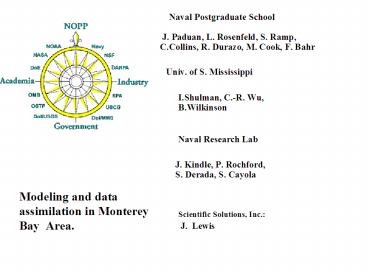ICON MODEL - PowerPoint PPT Presentation
1 / 26
Title:
ICON MODEL
Description:
J. Kindle, P. Rochford, S. Derada, S. Cayola. Naval Research Lab. Scientific Solutions, Inc. ... Modeling and data assimilation in Monterey Bay Area. ... – PowerPoint PPT presentation
Number of Views:286
Avg rating:3.0/5.0
Title: ICON MODEL
1
Naval Postgraduate School
J. Paduan, L. Rosenfeld, S. Ramp, C.Collins, R
. Durazo, M. Cook, F. Bahr
Univ. of S. Mississippi
I.Shulman, C.-R. Wu, B.Wilkinson
Naval Research Lab
J. Kindle, P. Rochford, S. Derada, S. Cayola
Modeling and data assimilation in Monterey Bay
Area.
Scientific Solutions, Inc. J. Lewis
2
Hierarchy of the different resolution models in
the Pacific Ocean.
Global (NLOM or NCOM)
PWC (POM or NCOM)
3
ICON MODEL
- Grid resolution 1-4 km, 30 vertical
- Open boundary conditions are derived from Pacific
West Coast (PWC) NRL model (resolution 10km). - Atmospheric forcing from
- NOGAPS and COAMPS predictions.
- Assimilation of CODAR data.
M2
M1
M3
M4
4
- The modeling objective of the NOPP ICON project
is to demonstrate the capability of a high
resolution model to track the major features in
an upwelling system when constrained by the
proposed measurement suite and nested within a
regional model.
5
V
Run 11 is on ONR ftp site
6
Observed and ICON model SSTsAugust 31, 1999
Santa Crus
Pt. Sur
7
NOGAPS is forcing for ICON and PWC
8
ICON with COAMPS, PWC with NOGAPS
9
COAMPS is forcing for ICON and PWC
10
Observed and model predicted MLDs (m).
0.1 C 0.2 C 0.1 C 0.2 C
11
Offshore core of the California current
California Undercurrent
12
Magnitudes of complex correlation of model
surface currents and CODAR currents with
velocities of the M2 first bin.
No Assim.
with CODAR assim.
CODAR
M2
13
Magnitudes of complex-correlation coefficients
between the ADCP and model-predicted currents at
M2.
14
CODAR
Assim.
No assim
15
- The model predictions demonstrated the
significance and importance of coupling the ICON
model with the larger-scale PWC model. - The model run with COAMPS 9km wind forcing better
captured the influence of the complex coastline,
displayed more observed details and produced
stronger headland effects. - The inclusion of high-resolution surface heat
fluxes from COAMPS predictions is important for
accurate prediction of the mixed layer shallowing
during the summer time.
16
- With high-resolution atmospheric forcing the ICON
model captures the essence of observed
hydrographic conditions. However, sometimes, the
details of observed variability are missed. - Assimilation of CODAR-derived surface currents
improves significantly surface and subsurface
model correlation with ADCP data.
17
ICON model improvements
- Implementation and testing tides
- Data Assimilation
18
Use of the circulation model for optimal sampling
of the bioluminescence intensity in the Monterey
Bay.
Naval Postgraduate School
Univ. of S. Mississippi
MBARI
S. Haddock
J. Paduan, L. Rosenfeld
I. Shulman
Naval Research Lab
WHOI D. McGillicuddy
J. Kindle, P. Rochford, S. Derada, S. Cayola
19
Prediction of the Bioluminescence potential in
the ocean represents a very challenging problem
- there is a lack of spatial and temporal coverage
of available BL observations for robust model
initialization - little is known about life cycles of autotrophs,
grazers, and predators producing the BL - little is known about the mathematical
formulation and parameterization of biological
processes governing BL variability in a complex
ecosystem.
20
Pilot Study of BL predictability (MUSE)
- How much of the short-term (2-3 days) of BL
variability can be explained by
advective-diffusive processess of the
tracermodel combined with the circulation model
and available limited BL observations? - Research has been focused on inferring and
predicting the location and intensity of BL
maximum. - Bioluminescence potential predictability
experiments - demonstrated the strong utility of the
circulation model in - predicting the location and intensity of the BL
maximum - over a 72-h period, and over distances of 25-35
km.
21
AA
BL maximums at 242d and 245th days are located in
the frontal areas representing a strong reversal
of flow direction.
BB
242d day
245th day
Bioluminescence
Cross-section model velocities
Section AA
Section BB
22
PLANObservational Program (S. Haddock)
23
OBJECTIVE
- Investigate utility of the circulation model in
- optimizing limited BL sampling for maximum
- impact on short-term (2-3 days) BL forecasts.
- AOSN HYPOTHESIS
(AOSN_II_Performance_Summary_2002_oct24.doc) - water seed populations control the biological
- community structure, in particular the
- bioluminescence constituents, in the region of
the - upwelling plume.
24
APPROACH (proposal on ONR ftp site)
- use ICON and frsICON models to study optimal
positions for BL sections during various
oceanographic seasons and various atmospheric
conditions. - study of the sensitivity of 3 day BL forecasts
with the tracer model to the locations of the BL
surveys. - investigate the relationship among 5 proposed
observational sections by tracking particles
advected from their initial locations along these
sections.
25
APPROACH (proposal on ONR ftp site)
- use of more objective approaches for optimal
observational design and adaptive sampling
adjoint-based, ensemble-based. - we will conduct this research in collaboration
with adaptive sampling group involved into AOSN
II experiment. - the inclusion of tidal forcing is crucial for
accurate BL predictions, which rely on short-term
particle tracking.
26
Other AOSN activities
- ICON model outputs for June-August of 2000 were
provided to adaptive and modeling groups. - Collaborate with adaptive and modeling groups on
testing their techniques with ICON model output
data. - Investigate outputs from ICON model to better
estimate the space-time evolution of the
upwelling plumes and their interaction with
California Current System (AOSN Hypothesis). - Collaborate with HOPS and ROMS group in AOSN II
modeling activities. - Conduct hindcast/nowcast runs of the ICON model
for time frame of the AOSN II experiment and
compare model outputs with forecasts produced
during the experiment.































